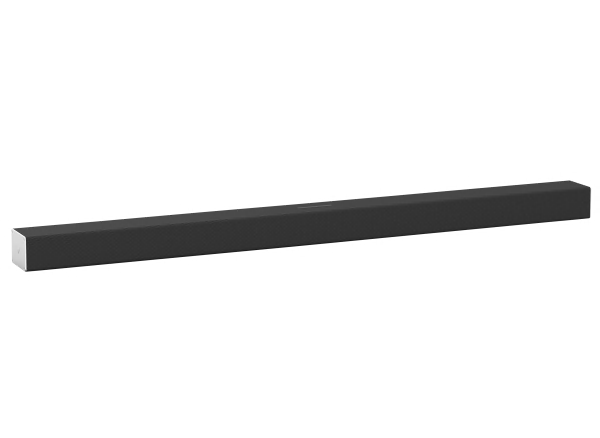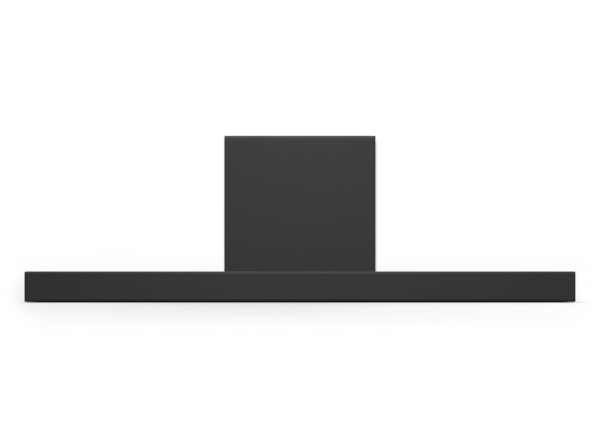Sound quality: Vizio's SB46312-F6 delivers sound quality that falls in the Good range - it reproduces music and dialog reasonably well despite the obvious shortcomings in its sound. In the Direct EQ mode the bass has good impact and goes deep, but is tubby and somewhat prominent. The midrange is fairly even but slightly grainy and hazy. Treble is fairly extended, but is a bit prominent and smeared. While this model does a decent job of recovering room ambience (the sense of the acoustic space in which the music was recorded), that ambience can be somewhat obscured by the tubby quality of the bass. With stereo program material the sound field extends slightly above and only to the ends of the front speaker array, and lacks front-to-back depth. In the Music EQ mode the sound field gets somewhat taller but not any wider, the midrange becomes somewhat thin, the bass becomes less prominent and a bit less boomy, and the overall sound gets diffuse and more echoey; sounds that should be in the center of the soundbar are heard to shift side-to-side along the width of the soundbar. The Movie EQ mode sounds very similar to the music mode but the midrange is not as thin and there is less reduction in bass prominence and boominess. The Virtual Height mode with stereo program material has no significant effect in the Direct and Music EQ modes, but in the Movie EQ mode it makes the midrange noticeably metallic sounding, more echoey, and makes it extended higher above the front speaker array. With Dolby digital and DTS multi-channel program material in the Direct EQ mode the sound image extends higher, and depending on the program material, may extend well past the sides of the soundbar, but still lacks depth. The Music and Movie EQ modes produced the same effects respectively as they did with stereo program material. The Virtual Height mode has no effect in the Direct EQ mode; in the Music and Movie EQ modes it makes the sound extend higher, but not above the listener and adds more echo. When playing Dolby Atmos material the width and height of the sound stage expands, and depending on the program material can fill the entire front of the room; audio imaging can extend overhead from the front to not quite over the listener's head, and sounds that should be coming from the sides and rear come from in front of the listener with sounds occasionally heard from the sides. The Music and Movie EQ modes effect the sound in a similar way as with stereo and 5.1 program material. There was no significant difference in sound quality between the HDMI, optical, coax, analog, USB, WiFi, and Bluetooth inputs. Dolby Atmos program material can only be played through the HDMI input. The system can provide satisfying volume in a medium sized room.
TV setup and ease of use: Very Good overall. Setup: HDMI CEC activation and deactivation is done on the connected TV and not on this unit, and the instructions come with this soundbar refer the user to the TV instructions. Programming the soundbar to respond to the remotes of most TV's, and activating or deactivating the soundbar's feature that lets it respond specifically to a Vizio TV remote was quick, easy, and straight forward - instructions included with unit indicate there are clearly marked settings in the menu built into the remote so there is no need to refer back to instructions after the initial use. All appropriate cables for TV connection included. Ease of Use: This model has several options that allow it to work seamlessly with your TV - it can be programmed to respond to most TV remote control volume and mute commands, it can be set to respond to the volume and mute commands of HDMI CEC compatible TVs without programming when connected via the HDMI ARC ports with and HDMI cable, and can be set to respond to the volume and mute commands of many Vizio TV remote controls. That's a good thing because the soundbar's response to its own remote's volume and input selection commands is sluggish and erratic. App remotes that operate via WiFi can also be downloaded onto Apple and Android mobile devices. The section of the app that can be used when watching TV was easy to use. The soundbar console's power, source, and volume controls are adequately identified and easy to access but hard to see due to poor contrast. Although the console lacks a mute button it can be unmuted by pressing one of the volume controls. The display consists of unlabeled patterns of indicator lights that can be seen from a typical listening positions but generally require referencing the instructions to decode. There's an indicator for power status, a momentary pattern for the source that's selected and the DSP effect mode that has been chosen, a momentary graphical volume display with very rough increments, and an indicator that shows when the soundbar has been muted.
Features setup and ease of use: Fair overall. Setup: Network streaming setup requires an app download to an Apple or Android mobile device, and is straight forward. The user is asked to set up an account that request first and last name, email address, and a password, but opening the account not required for full functionality. The soundbar has a LAN port, but the instructions that come with unit don't indicate how to connect with a LAN cable, there is no on-line user manual, and a LAN cable is not provided. Pairing a Bluetooth device requires a long press of the Bluetooth source selection button on the console or a menu selection on the remote - easy and straight forward. Ease of Use: The soundbar's response to its own remote's commands is sluggish and erratic. Apple and Android versions of app remotes that operate via WiFi can be downloaded on to mobile devices. These apps have general sections that are used to control the soundbar like a typical physical remote, and streaming player sections that are used to play audio streamed from the Internet through the soundbar. The general sections of both app versions were easy to use and glitch-free. The streaming player sections of both apps were not difficult to use, but were occasionally sluggish and glittchy. The Vizio apps can only stream audio content from iHeart radio; the soundbar relies on Chromecast apps for audio content streaming from other Internet service providers. The Vizio apps can't stream audio content stored on the host mobile device over WiFi; a Chromecast compatible third-party app is needed. Multi-room distribution is also done with Chromecast apps and not the manufacturer's app. The Internet streaming function sometimes didn't work regardless of whether Vizio or Chromecast apps were used. The soundbar console's power, source, and volume controls are adequately identified and easy to access but hard to see due to poor contrast. Although the console lacks a mute button it can be unmuted by pressing one of the volume controls. The display consists of unlabeled patterns of indicator lights that can be seen from a typical listening positions but generally require referencing the instructions to decode. There's an indicator for power status, a momentary pattern for the source that's selected and the DSP effect mode that has been chosen, a momentary graphical volume display with very rough increments, and an indicator that shows when the soundbar has been muted.
























